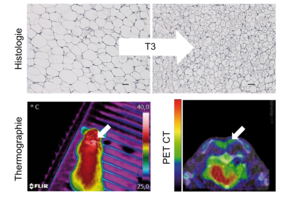Hyperthyroidism is a common disorder, which is often accompanied by elevated body temperature and an intolerance to warm environments. However, it is currently not understood how these symptoms are caused. Researchers at the Center of Brain, Behavior and Metabolism (CBBM) of the University of Lübeck have now in a mouse model unraveled the mechanism underlying these effects.
“The elevated body temperature in hyperthyroidism is a combination of thyroid hormone’s actions. First, the hormones act in skeletal muscle, where they increase the metabolic rate and thereby produce heat. Secondly, they act in the brain to elevate the central body temperature set point, similar to what observed in fever”, explains Professor Jens Mittag, leader of the study. “Our studies have shown that thyroid hormone moreover leads to the induction of brown or beige fat – a tissue that is currently of high therpeutic interest due to its capability to convert excess fat into heat”, adds <link research novel-concepts-of-body-temperature-regulation-by-thyroid-hormone.html _blank external-link-new-window internal link in current>Kornelia Johann, first author of the publication. “Remarkably, however, in hyperthyroidism the tissue seems to be inactive and does not contribute to the elevated body temperature or overall metabolism.”
These novel findings, which were discovered in collaboration with colleagues from Santiago de Compostela, Amsterdam, Cambridge, Hamburg and Cologne, have been published in the renounced journal “Cell Reports”. The researchers now aim to continue their work on thyroid hormone and body temperature regulation to understand how the beige or brown fat can be activated, as this could be of therapeutic benefit for metabolic disorders such as obesity or type II diabetes.
Ms Kornelia Johann received the Von-Basedow Award 2019 from the German Society of Endocrinology for her excellent work. The award ceremony took place on March 22 in Göttingen.
Publication
Kornelia Johann, Anna Lena Cremer, Alexander W. Fischer, Markus Heine, Eva Rial Pensado, Julia Resch, Sebastian Nock, Samuel Virtue, Lisbeth Harder, Rebecca Oelkrug, Mari-ana Astiz, Georg Brabant, Amy Warner, Antonio Vidal-Puig, Henrik Oster, Anita Boelen, Miguel López, Joerg Heeren, Jeffrey W. Dalley, Heiko Backes, Jens Mittag: “Thyroid Hormone Induced Browning of White Adipose Tissue Does Not Contribute to Thermogenesis and Glucose Consumption”, Cell Reports, online 11. Juni 2019.




